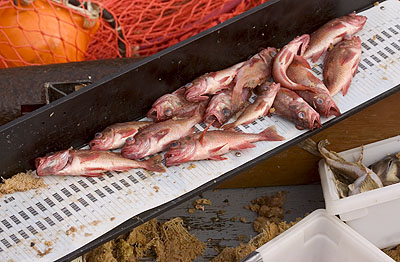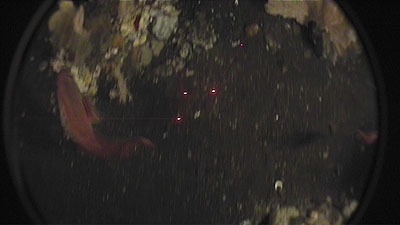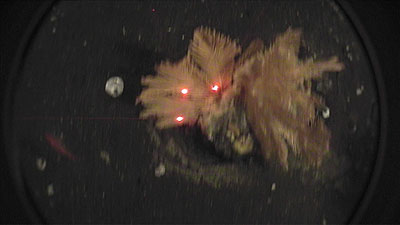
Juvenile POP captured in the bottom trawl.
The objective of this portion of the study was to examine juvenile POP presence-absence and abundance in video and trawl collections by study area and habitat type. We also used the underwater video to examine the strength of association of juvenile POP with structurally complex features.
Three to four video transects of varying length (1,172 to 3,725 m) and two trawl hauls were completed in each of the three study sites. Nine habitats based on substrate classifications were observed in the video. The SIN and SIS sites were dominated by sand and sand-boulder habitats, with some sand-cobble habitats mixed in. The IOFS site was characterized by more unconsolidated (rock) habitat and virtually no mixed sand-boulder habitat.
The video and trawl collections showed that juvenile POP abundance was higher at the SIS site than the other two sites (Fig. 1). The bulk of juvenile POP were observed in mixed sand-boulder habitat at the SIN and SIS sites (254 out of 321 individuals) (Fig. 2). At the IOFS site, only 6 juvenile POP were observed, and all were in cobble-boulder habitat.

Juvenile POP associated with boulder covered in sponge observed in a downward looking underwater video camera.
The position of each juvenile POP (n = 321) observed in the video relative to structured habitat was classified as: 1) within one body length of an object, 2) within 1 m of an object, or 3) minimal association (> 1 m away from a habitat object). At SIS, where the most juvenile POP were observed, on average over 80% of juvenile POP were observed within 1 body length of some type of complex vertical habitat structure (Fig. 3). Less than 2% of the juvenile POP at this site were not associated with any structure. At the SIN site, there was a more even distribution of habitat association, and no differences in the three types of association observed at the site.
The specific object associated with each juvenile POP observed on the video was also recorded (Fig. 4). At each site the majority of juvenile POP were associated with boulders. The boulders were usually covered with an invertebrate assemblage dominated by sponge or coral. In the rest of the cases, juvenile POP were associated with individual upright sponges or corals attached to the seafloor, cobble with a coral and sponge assemblage, crevices, or in one case a tangle of derelict longline gear.

Juvenile POP associated with boulder covered in coral species observed in a downward looking underwater video camera.
The substrates with the most juvenile POP were comprised of mixed sand and boulder fields, indicating this was the preferred habitat for these fish. Juvenile POP were utilizing the complex habitat provided by the boulders and associated epibenthic invertebrates for shelter, since the majority of individuals were found within one body length of structured habitat. Sponge and coral were common on all hard substrates encountered, and were prevalent on boulders in areas occupied by juvenile POP. Thus it was difficult to distinguish the relative importance of boulders and epibenthic invertebrates since these structures were found together and both provided structured habitat for juvenile POP.
Juvenile POP were found in high abundance at the SIS site where adult POP were uncommon, while the opposite was true at the SIN site (Fig. 5). Juvenile POP were observed to have a much shallower depth distribution than adult POP in NMFS bottom trawl surveys from 1994-2005 (Fig. 6). The geographic and bathymetric separation of adults and juveniles strongly suggests that boulder habitat in depths from 100-180 m serve as nursery areas for juvenile POP.

